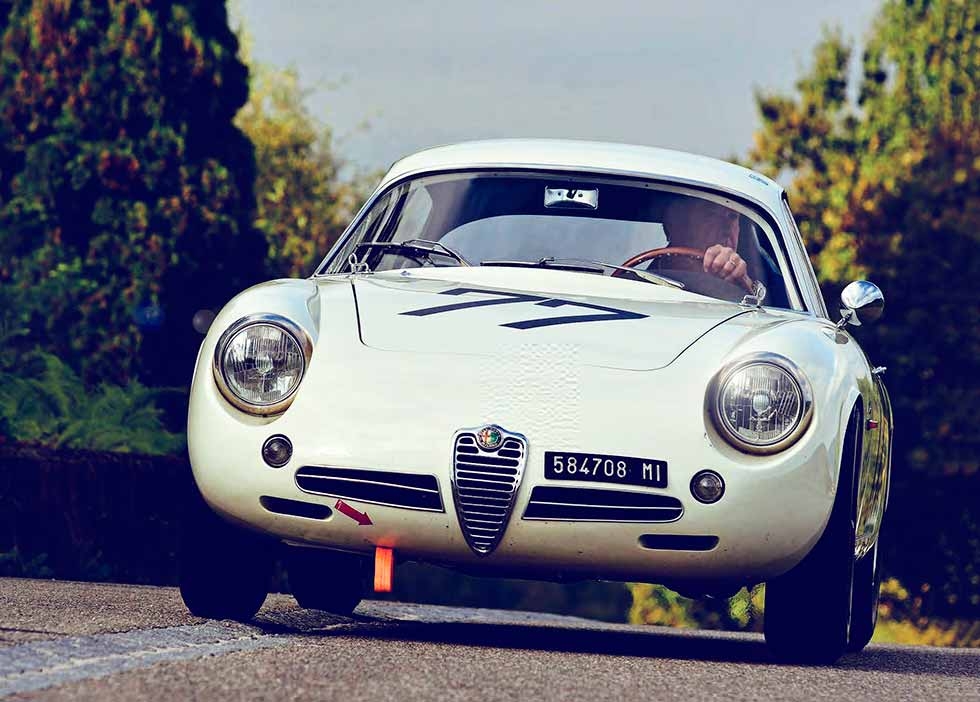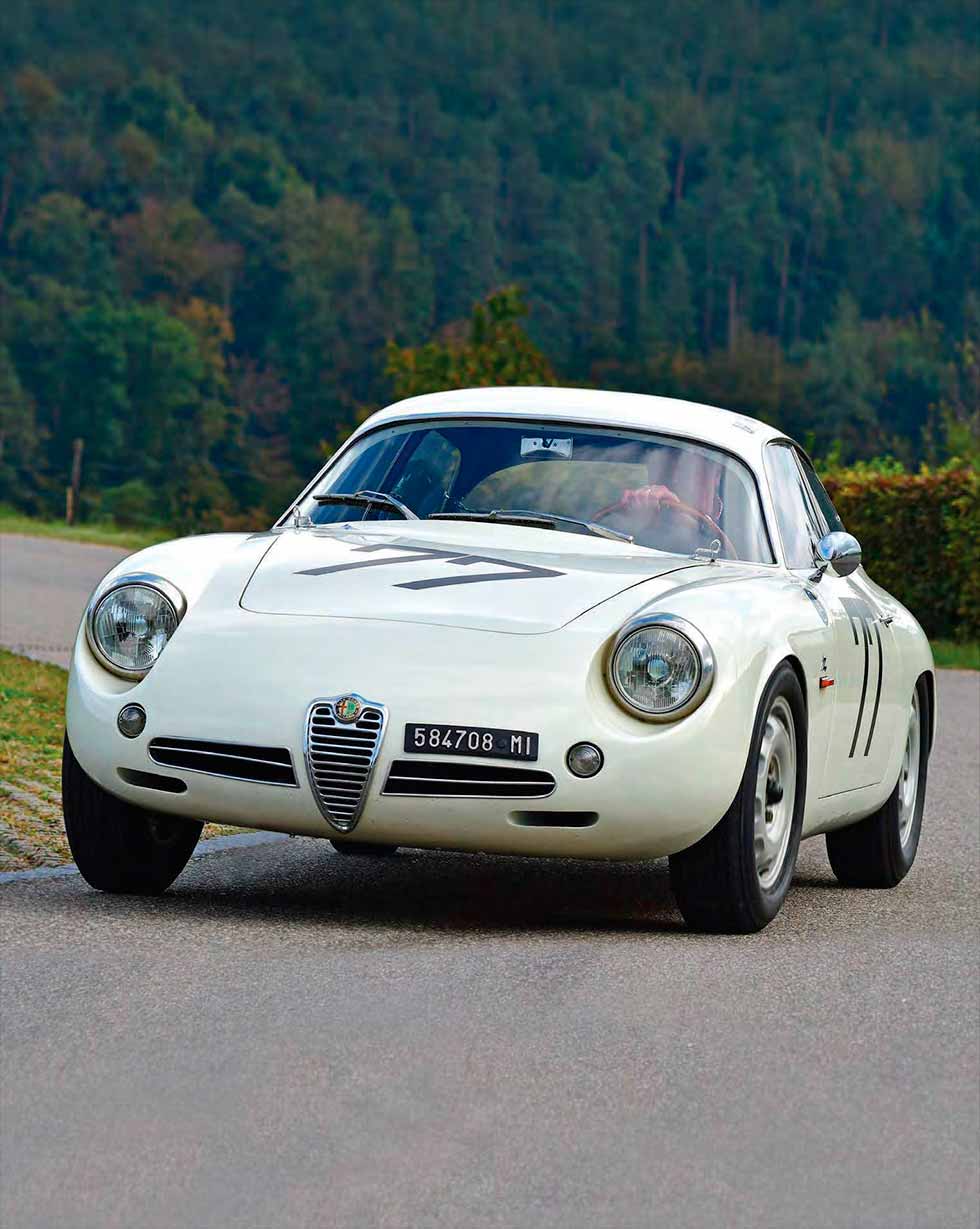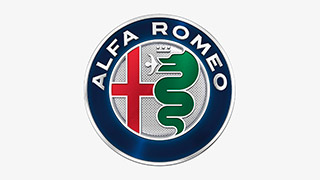
Alfa Romeo SZ Coda Tronca A rare and utterly delightful early 1960s Alfa Thereby hangs a tail. We drive an ult-rarare chopped-tail second-series Alfa Sprint Zagato ‘Coda Tronca’ – and quickly discover why the SZ is such a legend. Story & images by Peter Collins.
ALFA SZ: AERO HEAVEN
Sitting down to tot up the number of commercially available variants of the Alfa Romeo Giulietta, it is astonishing that there were no fewer than eight totally different models. Perhaps more surprisingly, looking at photos of what was left of the Alfa Romeo factory after WW2, is the fact that you could buy one at all. The Italian government had realised how vital industrialisation of the country was and quickly formed a state-owned company named IRI Finmeccanica to assist in the modernisation and recovery of the most devastated industries.

With this financial help and against the odds, Alfa Romeo developed the 1900, its first monocoque car. With a four-cylinder twin overhead camshaft engine of 1884cc it quickly became popular but it also quickly became clear that it was a car only the affluent could afford. The 1900 would not be enough to turn the company around and so the brains at Arese concluded that what was required was a more compact version with an engine of about two-thirds of its capacity: the Giulietta.
Organised by ex-Porsche/Volkswagen and Cisitalia/Siata man, Rudolf Hruska, it would be gratifying to say that all went well, and that the new car was launched to rapturous applause, but sadly this didn’t happen. Not because the car was inadequate, but because however talented the Alfa team was (with Giuseppe Busso responsible for mechanicals and Ivo Colucci designing the chassis), bringing the final vehicle to production proved very difficult. One problem in particular concerned an indefinable ‘rumble’ through the bodyshell on the road.
The first Giulietta was announced at the Turin Show in 1954 not as a berlina (saloon), but as a coupe. Hitherto manufacturers had usually always announced a new model series as a berlina first and then, over time, introduced estate, coupe and convertible versions later.
The official version given for doing this followed on from a Satta quote that Alfa Romeo stood for sportiness. However, there was a more fundamental reason as Finmeccanica had issued bonds based on the launch of the saloon on time and, on top of this, to stimulate sales, had offered new cars as prizes. Rudolf Hruska, having been offered a permanent job as Technical Director, reacted by saying, “Ma siamo matti” (‘we are crazy’). The fact was that only the Berlina’s platform chassis was ready and there was still a huge amount of work to be done before it could be considered ready for the showroom.
Then Hruska had an idea. What did Alfa Romeo mean to the general public? Answer: cars with a definite bias towards performance with a touch of style and glamour. What did he have available to him? Answer: a developed chassis.
So he went to Bertone to create the Sprint, one of the best-looking little coupes the world had ever seen. This exquisite car was powered by a 1290cc four-cylinder, twin-overhead camshaft engine derived from the Alfa 1900. It was rated at 65hp and coupled to a four-speed gearbox that, in early examples, was controlled via a steering column-mounted lever. Not surprisingly, within a year, owners started competing with their Sprints. Luciano Ciolfi gained the distinction winning first time out at Castelfuano in March 1955. After that, the Mille Miglia was the goal but, despite the car’s potential, the 1300cc GT class was taken convincingly by Porsches.
Alfa Romeo was stung into action and at the 1956 Turin motor show, a developed version was announced called Sprint Veloce. This was intended to redress the balance in motorsport as well as provide a more dynamic model for the road. It looked very similar apart from its sliding side and rear windows made of Plexiglas, plus the bonnet, bootlid and doors in aluminium. As well as weight saving, Alfa developed an upgraded engine fed by two side-draught twin-choke carburettors and with an increased compression ratio of 9:1 instead of 8.5, so it had 90hp at 6500rpm.
The plan worked well enough for the new Sprint Veloce to sweep the board, finishing 1-2-3 in class and 11-12-15 overall in the extremely wet 1956 Mille Miglia. Carlo Leto di Priolo and his brother, Dore, in their Sprint Veloce, when heading down from the Radicofani into a fast downhill left-hander with a bridge parapet at the bottom, felt the car begin to get away from them and, out of control, rolled over into the stream below before coming to a stop very badly damaged, with both crew injured. It seemed as if it would be possible to rebuild the car but, the story goes, the estimate for this work to be done by Alfa Romeo reached Carlo whilst he was still in hospital and he very nearly had a relapse.
By coincidence, the brothers also owned a Fiat 8V Zagato and it occurred to them that Elio Zagato might be able to help them. A tubular frame was constructed and a new body, to Elio’s brother Gianni’s design, took shape. The end result was much lighter and lower than the standard car, but still retained features such as the original central radiator grille.
The car debuted at Monza on 2 September 1956, in the Coppa Intereuropa race, with Massimo Leto di Priolo at the wheel. He duly won, having out-qualified Sprint Veloces in the hands of the likes of Jo Bonnier, by two seconds. The resultant publicity led other SV owners to beat a path to Zagato’s door where an updated, further-developed SV Zagato, as the car had been named, was under consideration.
Three further cars were built, after which the clamour from (very) wealthy amateur race drivers was such that Zagato decided to construct another 14 cars, but this time to a more coherent design. The upright radiator grille was changed to one that wrapped over a flatter and more curved nose. This led up to a lower roof that terminated in a short, rounded tail. The nose was very similar to ‘our’ car here and the 1290cc motor was now modified by some preparatori to produce a staggering figure well in excess of 100hp – it had started at half that figure.
Sporting successes continued. Frenchmen Bernard Consten and Jean Hebert were particularly quick in rallies with their SVZ (as the cars were now known) but Zagato had to deal with the fact that Alfa Romeo still did not consider the model to be one of its own, so to become an owner, you first had to buy a Sprint Veloce, then take it to Zagato, where it was chopped and rebuilt into an SVZ. This was an immensely expensive exercise until Alfa relented and agreed to supply Zagato with chassis, bulkheads and running gear, as turned out for the Sprint Speciale in 1960. These were based on a shorter chassis than the Sprint. Sergio Pedretti debuted the first Alfa factory-based SVZ in the sportscar race accompanying the May 1960 Naples GP and duly won his class.
It was during 1960 that designer Ercole Spada arrived at Zagato for a short time. This was when Dr Wunibald Kamm had been expounding his theories on aerodynamics, in particular the tails of cars. The theory had always been that in order to gain lower Cd figures and cleaner airflow, the tail of a car should taper down to a point, as in the long-tailed Maserati Tipo 61 Birdcage and OSCA sports racers. After much experimentation, however, Dr Kamm came up with the theory that if you cut that long tail off vertically, before it reaches its tapered point, not only would you save a little weight but also keep the advantages of the tapered tail without sacrificing much in the overall Cd figure. Spada applied the theory to the SZ by lengthening, by 150mm over the standard SZ, and tapering the tail, but terminating it vertically behind the rear window. He also incorporated a lower nose treatment and a lower roof so that in tests around Monza, Elio Zagato was around 6mph faster than in its predecessor. Spada also added disc brakes at the front and three leading-shoe drums at the rear. The proof of the aerodynamics was borne out at Le Mans where one was timed at no less than 220km/h (137mph) on the Mulsanne Straight. Astonishing.
Our featured car is one of these SZ Coda Troncas – ‘truncated tails’. It’s chassis number 00174, completed on 9 September 1961. According to Alfa historian, Fusi, some 62 SZs were constructed that year, the last year of SZ production, as 1962 was taken up with development of what became the TZ1.
Chassis 00174 was sold to none other than Massimo Leto di Priolo, the man who had raced the very first SZ to be built, back in 1956. He was a prolific Italian racer and a leading member of the Scuderia St Ambrosiana, a racing team based in Milan and named after the city’s patron saint. This team had had an illustrious past and amongst its founders were Italian greats such as Gigi Villoresi, Franco Cortese and Giovanni Lurani.
Compiling a history for 00174 has not been easy. The main event that it took part in was an ambitious run in the 1962 Sebring 12 Hours where it was piloted by the illustrious Carlo Facetti, alongside Di Priolo, achieving a laudable 12th place finish. The car ran with one of the first sets of front disc brakes fitted to the model and it’s the only example to have front brake air scoops fitted in the front valance. Originally it would have been fitted with bi-metallic Borrani wheels which the owner, Jason Wright, still has, but wisely he prefers to race it on stronger alloy examples.
Over the years, 00174 moved around northern Italy from custodian to custodian until Jason acquired it about 10 years ago. Since then it has been restored and maintained by Alfa expert, Ivo Salvadori of Basel, Switzerland. The superb result is what you see here. Racer it may have been, but taking it up into the hills above the city revealed what a totally useable little car this is. First problem, though, is getting in. This is a tiny, jewel-like machine with a very low roof, hence the great aerodynamics. Once installed, though, you would be happy to stay all day. No wonder they were great long-distance cars at Sebring, Le Mans or the Coupe des Alpes.
That little 1300cc twin-cam pulls like a train and goes like a rocket. It is very difficult to believe there are so few cubic centimetres involved. The whole machine fits like a glove and can be manipulated in the same way, with a light touch, easily making sure it goes wherever you want it to with economy of effort. All the time, you play delightful Alfa tunes changing up and down those five superbly chosen gears. The brakes are firm and progressive in a way that defines all Giulietta models. With all this and superb looks, too, you can see why the following TZs were so successful if they had this as a base point. What an amazing family of cars the Giuliettas turned out to be.
Any SZ is extremely rare but this one is unique in having brake cooling air scoops in the front valance. The cut-off ‘Coda Tronca’ tail was proven to be more aerodynamically efficient than the ‘teardrop’ shape.
TECHNICAL SPECIFICATIONS 1961 ALFA GIULIETTA SZ CODA TRONCA
ENGINE: 1290cc four-cyl twin-cam
BORE X STROKE: 74mm x 75mm
COMPRESSION RATIO: 9.7:1
MAX POWER: 100hp @ 6500rpm / DIN nett
MAX TORQUE: 130Nm (96lb ft) @ 5500rpm / DIN nett
BRAKES: Discs front and rear
FUEL SYSTEM: Twin Weber 40
TYRES: 155/15
DIMENSIONS: 3920mm (L), 1540mm (W), 1250mm (H)
WEIGHT: 770kg
MAX SPEED: 124mph






